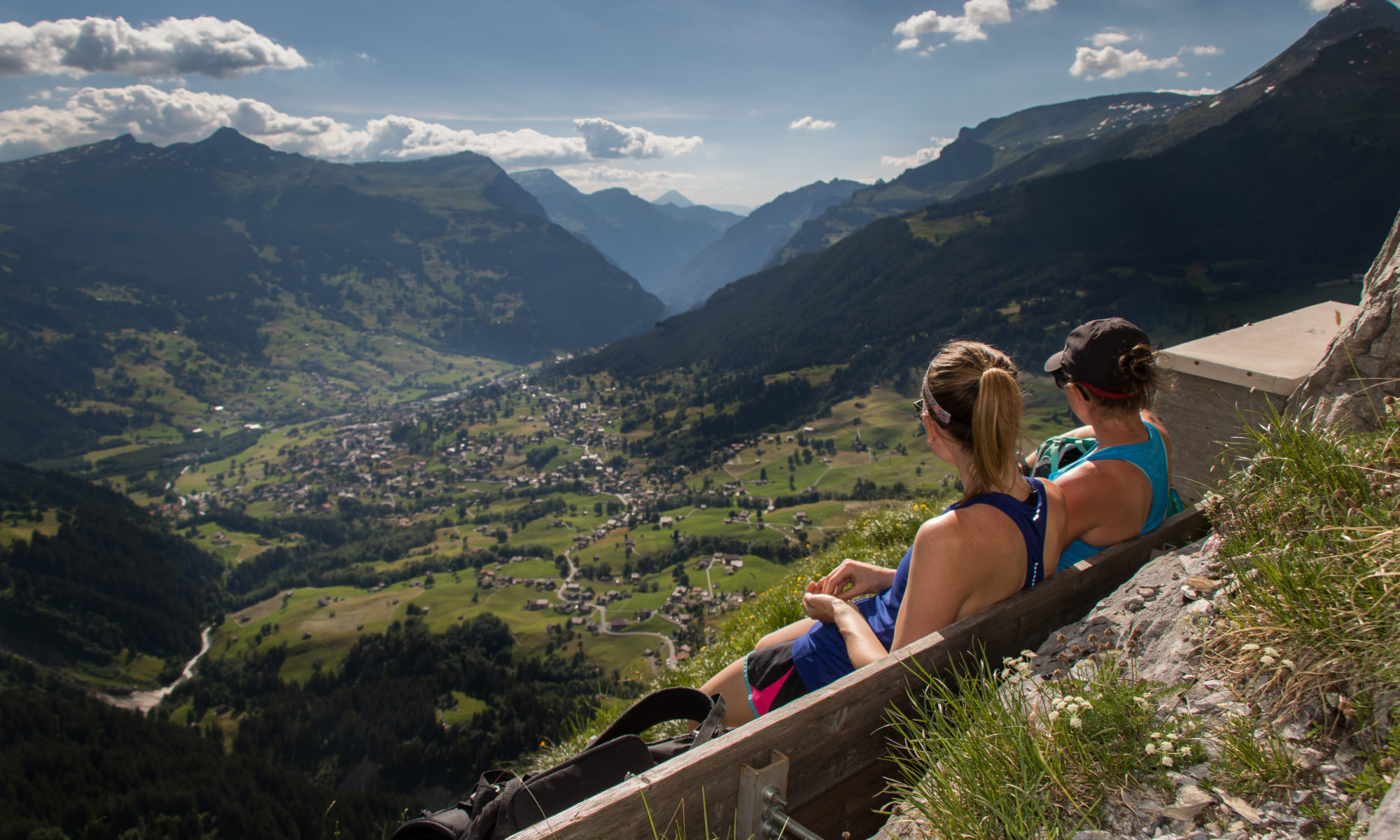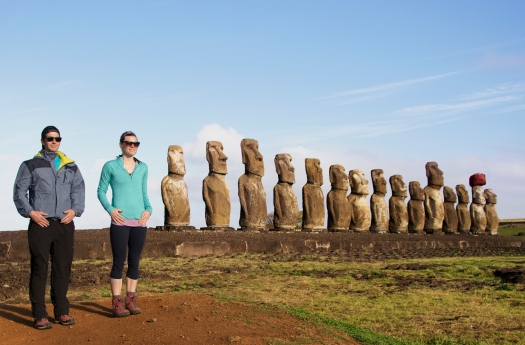
Easter Island is somewhere that has always intrigued me. With it’s natural beauty and mysterious history, it was a place I dreamed of visiting, but in reality wasn’t sure I would ever get to see with my own eyes. It’s one of the most remote islands in the world, and not easy to get to from most places. But, lucky for us, one of the few direct flights available to the island is from Santiago, so adding it to our list of travel destinations during our time here was a no brainer.
History
Before I dive into the details and highlights of our trip, let’s start with a little history. If you’re anything like me, you probably know that Easter Island is home of a lot of huge, stone statues and not much more. I feel like the general conversation about Easter Island goes something like this…
“Easter Island, that’s that place with the big statues, right?”
“Yeah, it’s crazy, they’re huge and nobody knows how they got there!”
Well, sort of. Though there is still a lot of mystery surrounding the Island’s history, particularly the giant Moai statues scattered across it, the origin of the statues themselves is known. The Island, which is only 15 x 7 miles, is home of 3 large volcanoes (and several other smaller ones). After the volcanoes erupted, their volcanic ash solidified, and the remnants of the eruptions of volcano Rano Raraku became the carving ground for these massive statues, which were part of the Rapa Nui people’s death tradition.
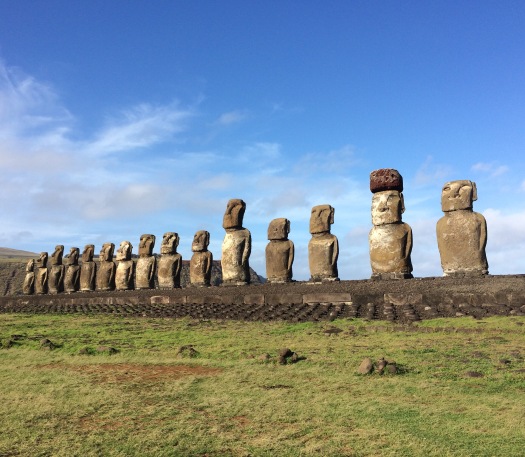
Basically, when someone in your community died, their body was cremated and the ashes left at a burial site called an Ahu. These Ahu’s were scattered around the island, and consisted of large platforms built from rock. Some Ahu’s were only the platforms, but over time, a new tradition was born to honor the death of community members who were believed to have a particularly strong spirit or “Mana”, by erecting a statue carved in their likeness. According to our hotel owner and tour guide, an American named Paul who originally came to the island to help with archeological restorations and later married a local Rapa Nui woman, the belief was that the spirit of the ancestors they represented would come to inhabit the statues, and provide protection. This is why all the statues are facing inward, away from the sea, so they could keep watch over the people of the community.
As time went on the statues got larger and larger. The real mystery is how they were moved from their carving ground to their final resting places throughout the island. The Rapa Nui legend is that the statues walked. There are many theories that attempt to explain how the islanders may have used ropes and trees to move the erect statues in a way that would have resembled walking, but we will never know exactly how they were transported. Regardless, it’s clear that it was quite a feat as the average Moai weighed 14 tons.
Our Trip
Because of the tropical climate on the island, the weather is relatively stable year round, so we decided July, winter in Chile, would be a good time to escape the mainland. After doing a bit of research, we decided to spend 5 days and 4 nights on the island. In my experience, this was a really nice length of time. It allowed us to see all the key archeological sights, take in the beautiful coastline and get a feel for life on the island, while not burning too much vacation.
Day 1 – Flight from Santiago and hike to Ranu Kao
We left Santiago early on Friday morning and arrived around 12:30pm. When we de-boarded at the tiny island airport, we were greeted with flower lei’s, sunshine and warm sea breezes. We made our way through the island’s one and only town, Hanga Roa, and arrived at Hotel Tekarera with plenty of time left in the day to explore.
Once we were settled in our room, we set out on foot in search of lunch and a trail. After scarfing down a tuna empanada the size of my head (we quickly realized that portion sizes on the island are ENORMOUS), we set our sights on the a trail that wrapped around the island’s southwest tip leading to the Ranu Kao volcano.
From town, it was about a 6km walk, which gains elevation as you near the volcano and opens up for some spectacular views back over town and the sea. It got pretty windy as we went, but the views were amazing, and it was a great way to get a taste for the Island’s beauty. At the summit there is also a small visitors center which serves as an entrance to the ruins of the ancient town of Orongo. Since we were going on a tour the following day, we saved this for later, and decided to turn back after taking in the view from the volcano’s rim.
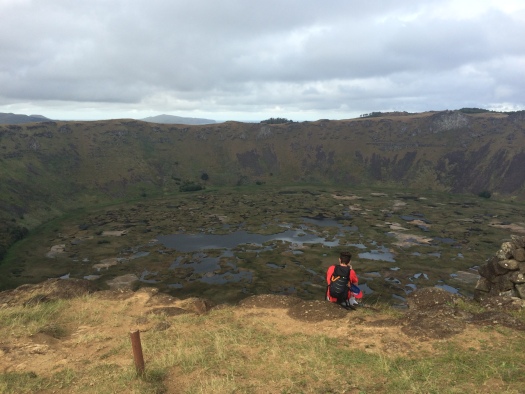
After a long walk back through town, we made it back in time to catch a sunset over Ahu Tahai. This Ahu features 5 restored Moai, positioned in a perfect location for watching the sun dip down at the end of the day. Lucky for us, it was also located just a short walk from our hotel, which meant we got to watch this site several times during our short stay.
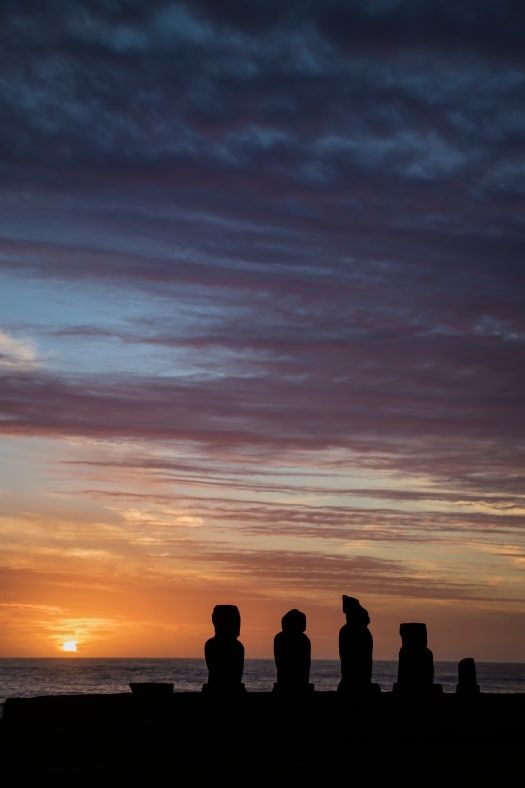
Day 2 – Guided Tour of the Island and Japanese Food
On Day 2, we opted for a full day guided tour, led by Paul, the owner of our hotel and an archeologist who had done a lot of restoration work on the island. I would highly recommend taking a tour through his company, Tekarera Tours, even if you aren’t staying at his hotel. Taking a tour on your first full day on the Island is a great way to get your bearings. While the island is small, the different historical sites are spread across it and it was helpful have a local along for the ride to point out lesser known points of interest and suggest places to revisit when we were on our own.
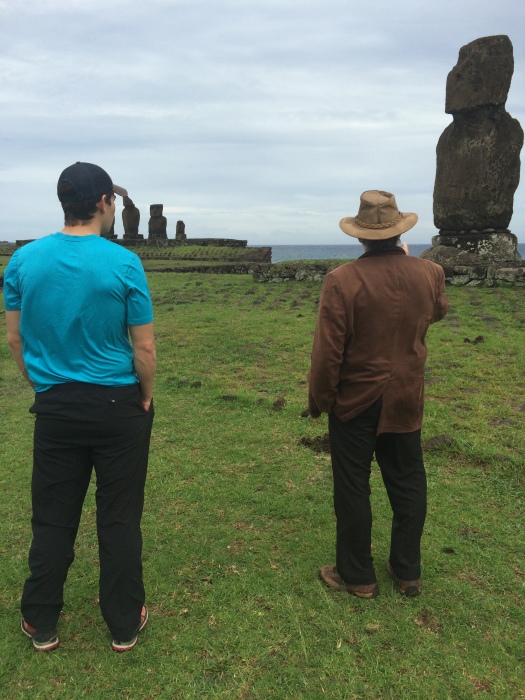
Paul is incredibly knowledgeable about the island’s history, both ancient and recent. He shared with us the aforementioned history of the famous Moai statues, and also shared with us much of the ongoing tension between the remaining Rapi Nui people and the Chilean government. While the Island is now part of Chile, there remains resistance, and within the last 6 months, the Rapi Nui people created road blocks and shut down parts of the park in protest, because they are unhappy about the Chilean government taking the proceeds from national park tickets.
During the morning hours, there were extremely high winds and overcast skies, but by the time the afternoon rolled around, we were greeted with sunshine. The weather on the island can be volatile, with intense winds and storms, but they pass quickly, and sunshine never seems to be far off. Just hold onto your hat when the wind kicks up. Matt almost lost his off the side of the island a couple of times. Also, be advised, if you have been living abroad and afraid to get a haircut a Spanish speaking salon, this may occur…

The highlight of the day for me was visiting Ranu Raraku, the volcano where the Moai Statues were carved. Here, you can get much closer to the statues, and really get a sense for how huge they are. The hillside of the volcano is covered in Moai, in various states of completion, and seeing them as works in progress really transports you back in time. We wandered along the outside of the volcano, and then circled back to the inside of the crater, where we sat beside the water and watched the clouds pass by. There was something utterly sublime about sitting inside a volcano that is thousands of years old.
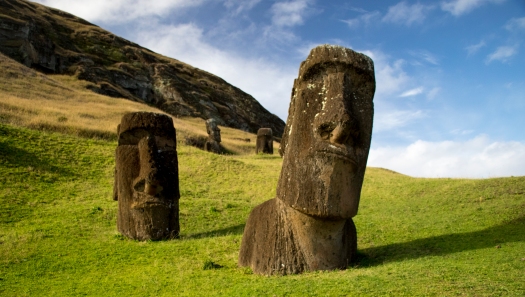
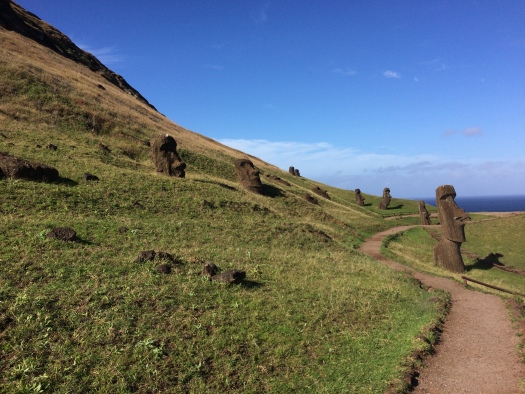
We ended the day at a Japanese restaurant, that came recommended by Paul and was an unexpectedly delightful experience. While most of the restaurants on the island serve hearty portions of ceviche, tuna and island grown mashed potatoes, Kotaro offered a unique experience. The chef built the restaurant himself, and uses his extensive culinary experience to cook creative and delicious Japanese food using the island’s somewhat limited ingredients. It’s a bit off the beaten path, but definitely worth a visit if you are on the island for any length of time.
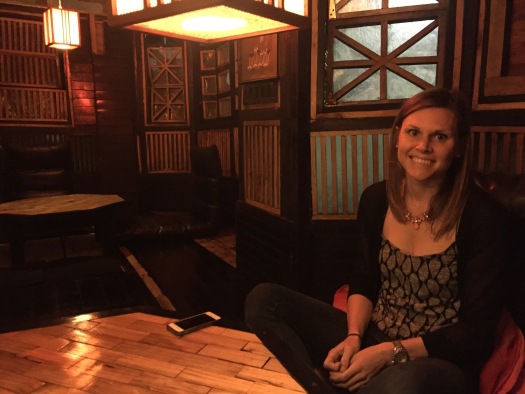
We closed out an action packed day with a trip to see a local dance show. While it was definitely a little touristy, it was a fun way to end the day and soak in the island vibes before heading to bed to rest up for another day of exploring.
Day 3 – Lava Tubes and Swimming Holes
On day 3 we were on our own. We opted to rent a car for days 3 & 4 of our trip. Despite the island being small, I would recommend renting a car (or a dirt bike), because there is so much to see on all sides of the island. As you can imagine, there are a limited number of cars, so many hotels rent out their own vehicles and prices are pretty affordable.
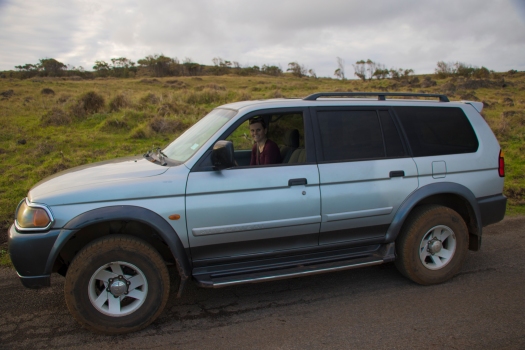
Since we had seen most of the important and popular Moai sites during our tour, we decided to spend day 3 exploring the coast and searching for caves. Because the island had so much volcanic activity, lava tubes have formed beneath the surface, forming an extensive network of caves. Many served as shelter for the islanders, and were turned to hideouts and homes during times of war.
We drove a ways along the coast before parking the car at a road block and continuing on foot. We were joined by one of the island’s many stray dogs, who served as our tour guide as we hiked along the island’s breathtaking coastline in search of the Cave of Two Windows. He walked with us, stopping to bark at herds of cows and sometimes running ahead to follow a scent, but always turning back to make sure we were still close by. When we finally reached the cave entrance, about a mile up the coast, he followed me right down the dark hole and into the tunnel.
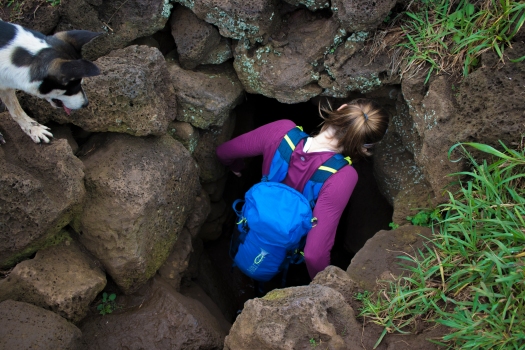
I haven’t spent much time in caves, so I was a little uneasy when we first started downward into the darkness, but fortunately the small entryway opened up fairly quickly into a large cavernous cave with two tunnels that opened outward to overlook the ocean. The view from the cave was breathtaking, and it was a prefect place to stop and relax.
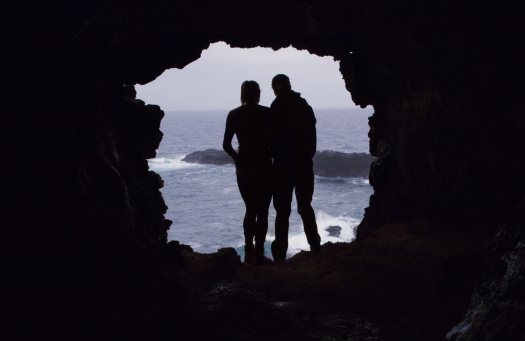
After we re-emerged, we spent a couple more hours walking along the coast, and checking out a few more caves. After the walk, we headed back to the car and decided to go in search of swimming hole. There are several “official” swimming holes which have been fortified, as well as countless others all around the island. Sunday seemed to be a popular day for locals to gather for a barbecue and a swim, so many of the larger swimming areas were occupied, but we managed to find a small, calm pool of water along the island’s south side. The water was a little cold, but refreshing and a nice end to a day of exploring.
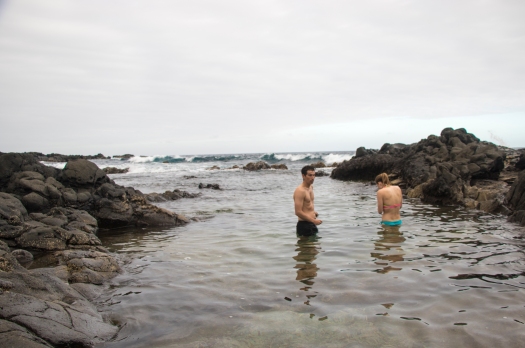
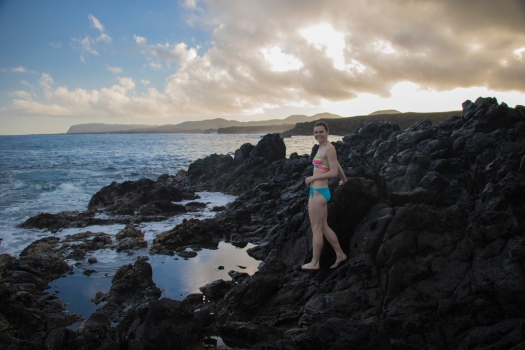
Day 4 – Hiking to the highest point and an afternoon at the beach
For our last full day on the island, we decided to hike up to the island’s highest point, the Teravaka Volcano. The trail to Teravaka starts at Ahu Akivi, and weaves through farmland, gaining elevation slowly. It was a bit difficult to know where exactly the peak was, as there are several smaller volcanoes and peaks of similar height, but after a bit of exploring we finally reached the top. From the peak, you get some incredible 360 views of the island, and can really get a sense for just how far you are from anything else.
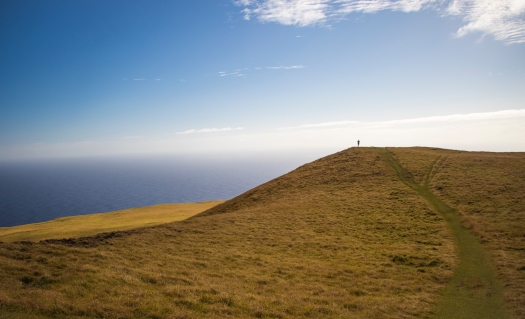
After our hike, we decided to head to the Island’s one beach, Anakena. We had lunch at one of the beachside restaurants during our tour, but due to the high winds and cloudiness, we didn’t get the full experience. Lucky for us, the weather was much better the second time around, and we spent some time relaxing and listening as the waves come in.
We also spent some time hiking the coastline near the beach. One of the incredible things about the island, is that it is essentially one big national park. While there are some restrictions on where you can take a car, you can pretty much hike anywhere you please on foot. This means you have some of the world’s most beautiful views all to yourself (well, yourself and whatever horses and cows may be grazing nearby).
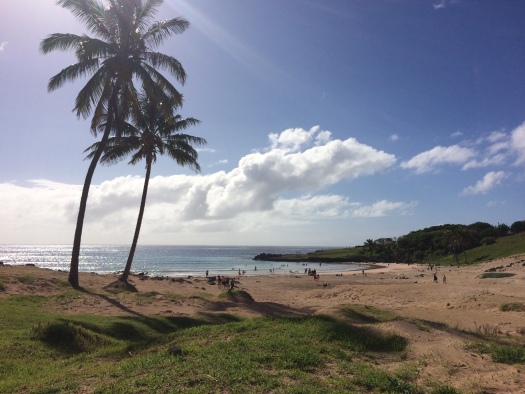
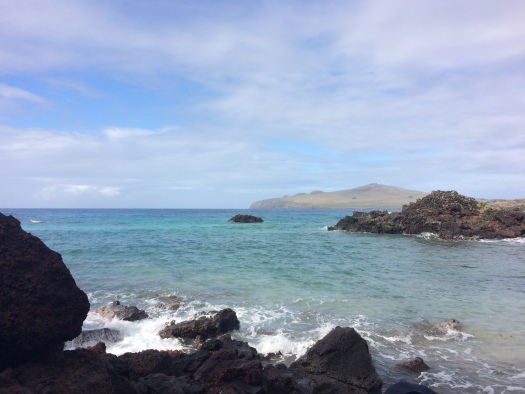
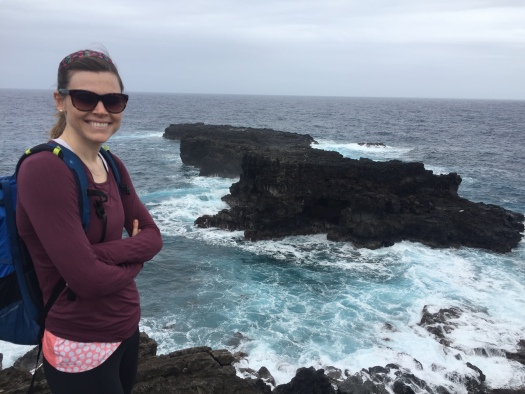
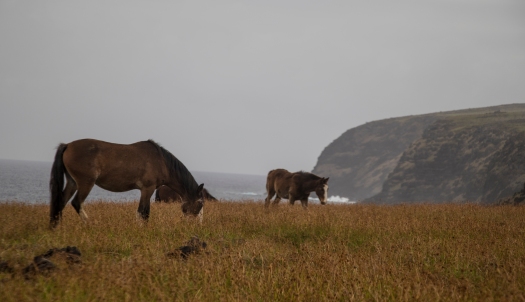
We closed out our last full day on the island with another swim, and another sunset. This time, we opted to watch the sun sink down while enjoying a beer and some ceviche on the back patio of La Kaleta.
Day 5 – Hanga Roa and Saying Goodbye
For our last morning on the island, we decided to head into town. Though we had driven through and had dinner in town a few times, we hadn’t really explored it on foot. We set off from our hotel, stopping to have a proper coffee (like Santiago, instant coffee abounds on Easter Island as well) at Mikafe.
Hanga Roa is small, but worth exploring. We meandered through some small souvenir shops and a small artisan market, grabbing a couple of gifts and postcards before heading back to the hotel to pack up.
We made it to the airport in plenty of time for our 2:00pm flight, and got to soak in some island sun as we waited in perhaps the most pleasant boarding gate in existence. We were sad to board the plane and leave this special, mysterious place behind.
